FIGURE I. UNICEF minimum quality standards for community engagement
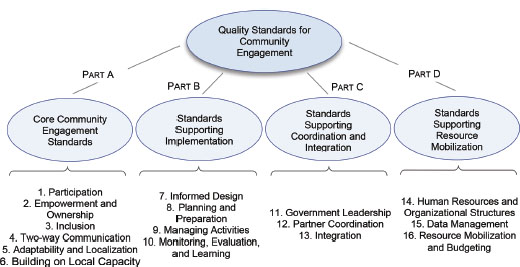
Source: UNICEF (2020).
https://doi.org/10.4438/1988-592X-RE-2023-402-598
Sebastián Araya-Pizarro
http://orcid.org/0000-0002-5857-8441
Universidad de La Serena
Nando Verelst
https://orcid.org/0000-0002-0957-767X
Universidad de La Serena
Abstract
Modern universities have the task of transferring skills, knowledge and values, that serves the students to engage with societal and environment challenges. This research aims to examine the research landscape in the field of university-community engagement. Methodology: A longitudinal descriptive bibliometric examination of the scientific literature published during the period 2017-2021, was applied. Data were obtained through the search in the Scopus and Web of Science databases, using the PRISMA declaration for systematic reviews. Bibliometric indicators were calculated to describe the production, dispersion, distribution and growth of the articles. Through bibliometric mapping, the co-occurrence networks of the most used terms and citations were explored. A thematic analysis was also performed using the categorization scheme of Callon et al. (1991). To analyze the data, the Bibliometrix R package and the Biblioshiny application were used, and the VOSviewer software were used to visualize the outputs of the network analysis. Results: There were 404 articles, which received 431 citations, mostly from the United States of America (277), with an average of 8 citations per document. The annual growth of the literature was 29%, with an exponential adjustment trend (R2= .93). Most of the authors published only one article (93%), mostly in the areas of education and health. Eight thematic clusters were found, distributed into motors, basics, niche and emerging topics. Conclusions: The study confirms a growing scientific production on community engagement, which is concentrated in few journals and numerous authors. Various topics are denoted (such as community engagement and development, service learning, and community-based participatory research) that have relevant implications for universities, higher education institutions and policymakers.
Keywords: community engagement, bibliometric analysis, university, Scopus, Web of Science.
Resumen
Las universidades modernas tienen la tarea de transferir habilidades, conocimientos y valores que permitan al estudiantado lograr un mayor compromiso con los desafíos de la sociedad y el medio ambiente. Esta investigación tiene como objetivo analizar el panorama investigativo del vínculo universidad-comunidad (community engagement). Metodología: Se aplicó un examen bibliométrico descriptivo longitudinal de la literatura científica publicada durante el periodo 2005-2021. Los datos fueron obtenidos mediante la búsqueda en las bases de datos Scopus y Web of Science, empleando la declaración PRISMA para revisiones sistemáticas. Se calcularon indicadores bibliométricos para describir la producción, dispersión, distribución y crecimiento de los artículos. A través del mapeo bibliométrico, se exploraron las redes de coocurrencia de los términos claves más utilizados. También se realizó un examen temático mediante el esquema de categorización de Callon et al. (1991). Para analizar los datos se utilizó el paquete Bibliometrix R y la aplicación Biblioshiny y, para la visualización de las salidas del análisis de red se usó el programa VOSviewer. Resultados: Hubo 404 artículos, que fueron publicados en 262 revistas, provenientes mayormente de Estados Unidos (277), con un promedio de 8 citas por documento. El crecimiento anual de la literatura fue de 29%, con una tendencia de ajuste exponencial (R2= .93). La mayoría de los autores publicó solo un artículo (93%) en las áreas de educación y salud. Se hallaron 8 clústeres temáticos distribuidos en tópicos motores, básicos, de nicho y emergentes. Conclusiones: El estudio confirma una producción científica creciente sobre community engagement, que se concentra en pocas revistas y numerosos autores. Se denotan diversos tópicos (como el compromiso y desarrollo comunitario, el aprendizaje-servicio y la investigación participativa basada en la comunidad) que tienen implicaciones relevantes para universidades, instituciones de educación superior y responsables de políticas públicas.
Palabras clave: community engagement, análisis bibliométrico, universidad, Scopus, Web of Science.
There is a growing demand for the review and reform of educational curricula in higher education, with the purpose of moving towards a more globalized and integral formation, according with the challenges inherent to the sustainable development of humanity (Chen, 2021; Zapp & Lerch, 2020). Thus, higher education institutions (HEIs) have the task of transferring skills, knowledge, and values that allow students and future professionals to achieve a significant link with social and environmental needs (Robertson, 2021).
In the academic context, community engagement (CE) seeks to establish a sustainable, holistic, and reciprocal relationship between academia and the community (Sheila et al., 2021). This relationship is materialized through the execution of relevant research projects for community stakeholders (Machimana et al., 2021) and active learning activities that encourage student engagement with diverse communities (Bidandi et al., 2021). In this regard, universities have the potential to contribute to the development of social (relational) capital through actions of creation and knowledge transfer in the different disciplinary fields in which they operate (Breznitz & Feldman, 2012; Johnston & Lane, 2018). Specially, considering that the notion of “engaged university” has been distinguished as a plausible model for higher education (Dougnac, 2016; Johnston et al., 2021).
Despite the transversal recognition of the importance of CE, its development in the university activity is still incipient (Bidandi et al., 2021) and its relevance, as a research topic, is recent. This provides the opportunity to build a broad and detailed overview of academic research on CE that synthesizes the state of the art, trends over time, key topics, and future trends in this area.
Bibliometric analysis, on the other hand, is a method for studying large volumes of scientific data based on semantic units such as keywords, and production units such as countries, institutions, journals, and authors (Aria & Cuccurullo, 2017; Donthu et al., 2021). In addition, it has the potential to define relevant trends and themes (both primary and emerging) through the application of scientific mapping techniques, providing a general view of the field of study (Callon et al., 1991).
This article aims to analyze the research landscape on the study of community engagement in universities, based on the bibliometric review of the two leading bibliographic databases in the world: Web of Science (WoS) and Scopus (Zhu & Liu, 2020). The analysis horizon includes the last 17 years (2005-2021), a period in which a continuous production of scientific research on the subject is observed. In this way, it is expected to contribute to the understanding of the university-community engagement phenomenon with bibliometric evidence; a prominent topic, but characterized by heterogeneity in its conceptualization and territorial theoretical development (Compagnucci & Spigarelli, 2020; Dougnac, 2016).
Community engagement is a collaborative work process with a group or groups of people to meet their needs or improve their well-being (Levin et al., 2021). According to Johnston and Lane (2018), this process is intimately linked to the concept of relational capital, a fundamental resource for the functioning of a democratic society.
In this line, universities CE is a topic that is gaining global relevance (Groark & McCall, 2018). It is understood as a process that brings together actors from civic associations and non-profit organizations, public institutions, private organizations, and universities, to form sustainable relationships aimed at improving the collective well-being of community stakeholders through collaborative actions and programs. Examples of such actions include project-based learning, service-learning, and applied research on socially relevant topics (Unger & Polt, 2017).
For this reason, it is argued that the systematic application of CE actions by universities strengthens their social responsibility since, by addressing the local and regional concerns of the territory, institutions manifest their commitment to the sustainable development of a country. Likewise, CE contributes to improving students' academic, social and employability skills, through active learning strategies (Bhatnagar et al., 2020; Mbah et al., 2021).
Although there is no global consensus on what are the basic dimensions that determine the university-community link, it is important to note that the United Nations Children's Fund (UNICEF) established 16 minimum quality indicators that serve as benchmarks to guide the development of CE programs and actions in humanitarian contexts (Figure I). Other reference frameworks for CE have also been proposed, mainly in the health area, which share elements with the model proposed by UNICEF (Lavery et al., 2010; McNaughton & Duong, 2014; UNICEF, 2020).
FIGURE I. UNICEF minimum quality standards for community engagement

Source: UNICEF (2020).
Regarding higher education and university management, different studies have systematized and analyzed topics such as university-industry collaboration and entrepreneurial universities (Forliano et al., 2021; Skute et al., 2019; Zavale & Langa, 2018). The article by Compagnucci and Spigarelli (2020) stands out by examining the concept of the third university mission (contribution to the community and territories) and concluding that the university-community engagement must necessarily be interpreted as a bidirectional and dialogic process with the communities. Additionally, the authors highlight the high heterogeneity existing in the concepts involved, the interpretation of their function, the way in which they can be addressed, and the impacts they can generate.
On the other hand, the theoretical proposal of Bender (2008) recognizes three general roles of higher education institutions (teaching and learning, research, and community service) that are connected through interaction interfaces and incorporate the community as a preponderant factor, conforming a model that defines general CE strategies consistent with the functions of HEIs (Figure II).
FIGURE II. Theoretical model of CE in higher education
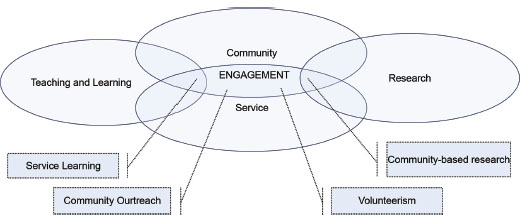
Source: Bender (2008).
In this sense, it is relevant to mention that the concept of Community Engagement involves the processes of linking organizations with communities, community participation in activities of general interest, and institutional commitment to the sustainable development of the community and territory (Richardson et al., 2021).
Moreover, some articles have explored the CE research field through bibliometric analysis, although mostly limited to the health area. Overall, all of these studies highlight the importance of joint working between public institutions, leaders, and community members towards a goal of common interest. For example, Yuan et al. (2021) examined, through bibliometric mapping techniques on the Web of Science, the literature on CE in public health. Gilmore et al. (2020) and Osborne et al. (2021) reviewed the field of CE in relation to strategies for preventing infectious diseases. Among the databases consulted by these authors are the Web of Science (Osborne et al., 2021) and Scopus (Gilmore et al., 2020). On the other hand, Ryan et al. (2020) explored, in Web of Science, Scopus, and other directories, the linkage of institutions with the community for natural disaster preparedness. In this way, this study provides updated and significant information on CE from a different and underexplored area, university education, based on the review of Web of Science and Scopus repositories, platforms widely highlighted for their visibility, scope, and international recognition.
The methodological process was based on the standardized workflow proposed by Zupic and Čater (2015), which establishes a procedure of five sequential phases: study design, data collection, data analysis, data visualization, and data interpretation.
The study design is based on a quantitative approach, descriptive type and longitudinal scope. To measure the current state of the field of study on CE and its development over time, a bibliometric analysis and network mapping of the literature published during the period 2005-2021 was applied.
Data was collected by searching the two most recognized bibliographic databases worldwide, WoS and Scopus (Zhu & Liu, 2020), using the PRISMA statement for systematic reviews (Moher et al., 2009). In phase 1 involved the search for articles took place; in phase 2 duplicate publications were removed; and in phase 3, articles that did not meet the inclusion criteria were discarded. Article eligibility parameters were decided in phase 4, focusing on the premise that they were documents written in English that dealt with the university CE. The review in WoS yielded 158 documents, while Scopus yielded 558. The search was conducted on August 5th, 2022. Both datasets were merged using a script written in R language, leaving the final database composed of 404 documents (Figure III).
FIGURE III. Study selection flow according to the PRISMA Declaration
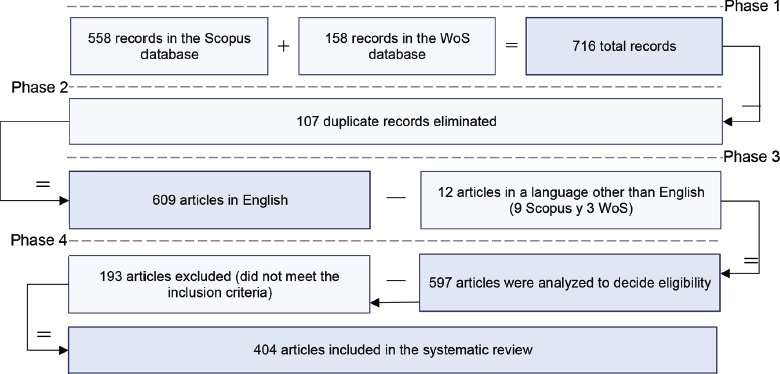
Source: Compiled by author.
The search and selection strategy were carried out through the application of Boolean terms (“university” OR “community engagement”) AND (“community engagement” OR “community participation” OR “community involvement” OR “community consultation”), using titles and keywords. This is in line with the work developed by Yuan et al. (2021). The option to incorporate only studies in English is based on the difficulty of articulating an accurate translation of the Anglo-Saxon concept engagement (Dougnac, 2016).
The inclusion criteria used were: 1) empirical studies published in scientific journals; 2) scientific articles that were in their final publication stage; 3) articles published from January 1, 2005 to December 31, 2021 (inclusive); and 4) studies focused on investigating university-community engagement.
For the analysis of collected data, a compilation of bibliometric techniques and network mapping was applied (Cobo et al., 2011; Muñoz-Leiva et al., 2012). Indicators describing the production, dispersion, distribution, and evolution of articles were calculated. Furthermore, the growth of scientific literature (Price's law), the concentration of authors (Lotka's law), and the Bradford model were calculated.
Moreover, through bibliometric mapping, the co-occurrence networks of the most used terms were explored, and an analysis of keyword trends and a thematic examination were carried out using the categorization scheme of Callon et al. (1991). This algorithm, by estimating the parameters of centrality (degree of interaction of the network with other networks) and density (strength of internal associations of a group), categorizes research themes into four dimensions: motor themes (high centrality and density), basic themes (high centrality and low density), niche themes (low centrality and high density), and emerging or declining themes (low centrality and density).
Finally, it should be noted that Bibliometrix package and Biblioshiny app, both developed by Aria and Cuccurullo (2017), were used to analyze the data. While for the visualization of the bibliometric networks maps the VOSviewer program was used.
In total, 404 documents from 262 journals were retrieved. The annual growth rate was 28.9%, with an average of 8 citations per article. A total of 1,582 automatically-generated keywords (Keyword Plus) and 1,158 author keywords were identified. Additionally, 1,424 authors contributed to the field of CE, with 69 of them being single-author document authors. The average number of co-authors per document was 3.8, and the international co-authorship rate was 5% (Table I).
TABLE I. Sample characterization
Dimension |
Descriptor |
Result |
Scientific production |
Timespan |
2005:2021 |
Sources (Journals, Books, etc.) |
262 |
|
Annual Growth Rate % |
28.89 |
|
Documents |
Total documents |
404 |
Document Average Age (years) |
5.03 |
|
Average citations per document |
8.015 |
|
Keywords Plus (ID)) |
1,582 |
|
Author's Keywords (DE) |
1,158 |
|
Authors |
Authors |
1,424 |
Authors of single-authored documents |
69 |
|
Collaboration |
Single-authored documents |
72 |
Co-Authors per documents |
3.83 |
|
International co-authorships (%) |
4.95 |
Source: Compiled by author.
The scientific production during the period 2005-2021 showed a positive trend, with an average annual growth of 29% (Figure IV).
FIGURE IV. Evolution of scientific production on CE, period 2005-2021
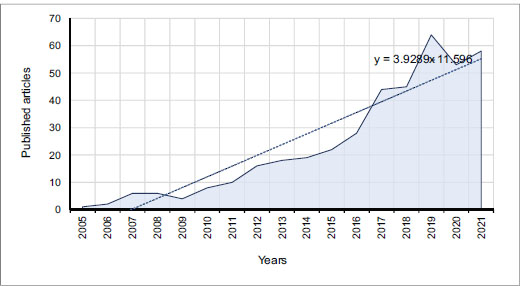
Source: Compiled by author.
The linear fit of the time series revealed an increase of four articles per year (β= 3.93, R2= .89). Moreover, it is possible to confirm that the temporal evolution of scientific production mainly adheres to an exponential model (β= 0.23, R2= .93), fulfilling the postulates of Price's Law of exponential growth of literature (Table II).
TABLE II. Linear and exponential estimation of scientific production growth
Equation |
R2 |
F |
Significance |
Constant |
β |
Linear |
.888 |
118.53 |
.000*** |
-11.60 |
3.929 |
Exponential |
.925 |
184.37 |
.000*** |
1.73 |
0.232 |
Note: y = Number of publications; x = Time periods (1-17), *** p< .001.
Source: Compiled by author.
Figure V shows that the countries with the highest scientific production were, in decreasing order, the United States of America (277 articles), South Africa (68), Australia (49), Canada (34) and the United Kingdom (19). These results confirm the undisputed leadership of the United States, which would be explained by its territorial extension, which hosts important institutions, centers, and research groups recognized worldwide, as well as by the language in which they publish (English).
FIGURE V. Geographic distribution of scientific production
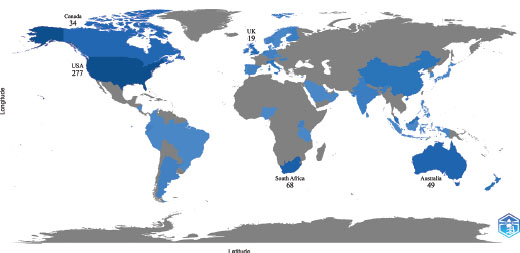
The map highlights in blue tones, from darkest to lightest, the countries with the highest to lowest scientific production on CE. Source: Compiled by author.
In the ranking of the 10 most productive institutions, the dominance of American (6) and South African (3) universities stands out, with a total of 57 and 20 publications, respectively. The most relevant institution was Johns Hopkins University School of Medicine (14), followed by the University of California (13) and the University of North Carolina (9) (Table III).
TABLE III. Top ten most productive institutions
Ranking |
Institution |
Country |
Publications |
1 |
Johns Hopkins University School of Medicine |
USA |
14 |
2 |
University of California |
USA |
13 |
3 |
University of North Carolina |
USA |
9 |
4 |
University of Pretoria |
South Africa |
8 |
5 |
University of British Columbia |
Canada |
8 |
6 |
University of Washington |
USA |
8 |
7 |
University of Wisconsin-Madison |
USA |
7 |
8 |
Durban University of Technology |
South Africa |
6 |
9 |
North West University |
South Africa |
6 |
10 |
Rowan University |
USA |
6 |
Source: Compiled by author.
The main authors published a maximum of 4 articles each, demonstrates the low-density present in the authorship of scientific production on CE. The most productive researchers were Brown, Govender, Salzer, and Weerts (Table IV).
TABLE IV. Top ten most productive authors
Ranking |
Author |
Publications |
Percentage |
H-index |
Total Citations |
Citations per article |
1 |
Brown, A. |
4 |
1.0 |
3 |
43 |
10.8 |
2 |
Govender, I. |
4 |
1.0 |
2 |
8 |
2.0 |
3 |
Salzer, M. |
4 |
1.0 |
3 |
77 |
19.3 |
4 |
Weerts, D. |
4 |
1.0 |
3 |
240 |
60.0 |
5 |
Brown, K. |
3 |
0.7 |
3 |
30 |
10.0 |
6 |
Brusilovskiy, E. |
3 |
0.7 |
2 |
72 |
24.0 |
7 |
Ebersohn, L. |
3 |
0.7 |
2 |
13 |
4.3 |
8 |
Eloff, I. |
3 |
0.7 |
1 |
6 |
2.0 |
9 |
Kruss, G. |
3 |
0.7 |
2 |
32 |
10.7 |
10 |
Machimana, E. |
3 |
0.7 |
1 |
8 |
2.7 |
Source: Compiled by author.
The examination of author concentration, through Lotka’s Law (Lotka, 1926), confirmed the high dispersion present in the reviewed production. Specifically, it was determined that 92.8% of authors have published one document, 6.1% have published two articles, and only 1.1% have published more than two articles (Figure VI).
FIGURE VI. Lotka's Law

Source: Compiled by author.
Table V shows that the journals that have published the most on CE belong to the fields of education and health. The most relevant sources were the Journal of Higher Education Outreach and Engagement (16), Progress in Community Health Partnerships: Research, Education, and Action (13), and Gerontology and Geriatrics Education (9).
TABLE V. Top ten most productive journals
Ranking |
Journal |
Publications |
Percentage |
Total Citations |
H-Index |
Research domain |
1 |
Journal of Higher Education Outreach and Engagement |
16 |
4.0 |
39 |
3 |
Education |
2 |
Progress in Community Health Partnerships: Research, Education, And Action |
13 |
3.2 |
36 |
3 |
Education |
3 |
Gerontology and Geriatrics Education |
9 |
2.2 |
61 |
5 |
Education |
4 |
Higher Education Research & Development |
6 |
1.5 |
56 |
4 |
Education |
5 |
International Journal of Environmental Research and Public Health |
6 |
1.5 |
30 |
2 |
Public, Environmental and Occupational Health |
6 |
American Journal of Community Psychology |
5 |
1.2 |
59 |
3 |
Public, Environmental and Occupational Health |
7 |
Educational Leadership |
5 |
1.2 |
3 |
1 |
Education |
8 |
Journal of Geography in Higher Education |
5 |
1.2 |
32 |
4 |
Education |
9 |
South African Journal of Higher Education |
5 |
1.2 |
3 |
1 |
Education |
10 |
South African Review of Sociology |
5 |
1.2 |
48 |
3 |
Social Sciences |
Note: Total citations and H-Index (Source Local Impact), Research domain by Scimago.
Source: Compiled by author.
The analysis of productivity according to publication sources showed a concentrated distribution. Specifically, the calculation of Bradford's Law (Bradford, 1985) revealed a high degree of correlation (R2 = .97) that shows that most publications on CE are present in a small nucleus of journals (Figure VII).
FIGURE VII. Source grouping through Bradford's Law
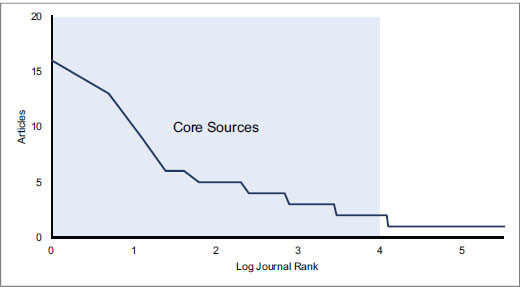
Source: Compiled by author.
The most cited article (125) was “Community Engagement and Boundary-Spanning Roles at Research Universities” by Weerts and Sandmann (2010). The same authors published the second most cited article, “Building a Two-Way Street: Challenges and Opportunities for Community Engagement at Research Universities” (Weerts & Sandmann, 2008). Both studies explore the concept of community engagement promoted by universities carrying out research actions. Studies by Winter et al. (2006), “University-community engagement in Australia”, and Bender (2008), “Exploring conceptual models for community engagement at higher education institutions in South Africa”, analyze CE practices and models in higher education institutions in Australia and Africa, respectively. On the other hand, Pommier et al. (2020) and Salzer et al. (2014) address methodological aspects for measuring of community engagement (Table VI).
TABLE VI. Top ten most cited articles
Ranking |
Article title |
Author (year) |
Total Citations |
Citations per year |
1 |
Community Engagement and Boundary-Spanning Roles at Research Universities. |
125 |
9.6 |
|
2 |
Building a two-way street: Challenges and opportunities for community engagement at research universities. |
104 |
6.9 |
|
3 |
The Development and Validation of the Compassion Scale. |
58 |
19.3 |
|
4 |
University-community engagement in Australia. |
57 |
3.4 |
|
5 |
Measuring community participation of adults with psychiatric disabilities: Reliability of two modes of data collection. |
53 |
5.9 |
|
6 |
Exploring conceptual models for community engagement at higher education institutions in South Africa. |
53 |
3.5 |
|
7 |
Outcomes of Australian Rural Clinical Schools: A Decade of Success Building the Rural Medical Workforce Through the Education and Training Continuum. |
52 |
6.5 |
|
8 |
The scholarship of university-community engagement: Interrogating Boyer’s model. |
47 |
6.7 |
|
9 |
Town-gown relationships: Exploring university-community engagement from the perspective of community members. |
46 |
2.7 |
|
10 |
Benefits and challenges of incorporating citizen science into university education. |
42 |
7.0 |
Source: Compiled by author.
The main keywords used by the authors were: community engagement (194), higher education (60), service learning (20), university-community engagement (19), community-based participatory research (15), universities (12), and community participation (11) (Figure VIII).
FIGURE VIII. Keywords most used by authors
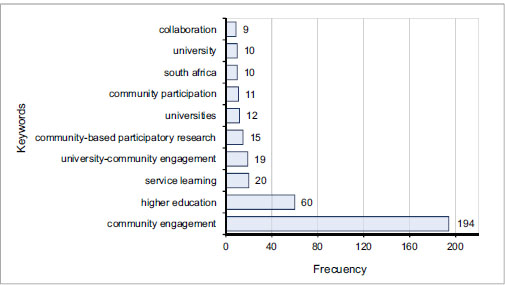
Source: Compiled by author.
The bibliographic coupling analysis, according to the consulted database, confirmed the predominance of the keywords community engagement, higher education, and service-learning, as observed in the density visualization maps in Figure IX.
FIGURE IX. Keyword density visualization map according to bibliographic database
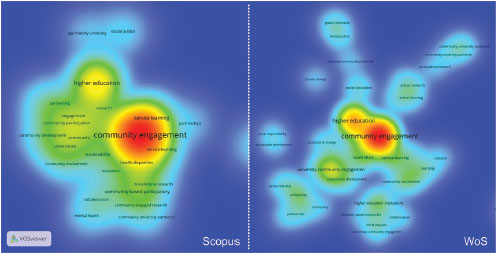
Source: Compiled by author.
Figure X shows the co-occurrence network of author keywords. In the bibliometric map, the size of the nodes is proportional to the frequency of occurrences and their relative weight, through which the terms were related to each other. The central clusters of the map indicate a high interrelation with the basic concepts that conform it, while those located at the ends indicate a low interrelation. Thus, five central nodes of co-words (community engagement, higher education, community-based participatory, audience and social justice) were registered in the network, whose examination (degree of centrality of the network) ratified the term CE as the main source for interaction and linkage with the other keywords of the reviewed articles. This topic recorded levels of intermediation and closeness of 936.3 and 0.019, respectively, much higher than other concepts such as higher education (54.1 and 0.012) or community-based participatory (31.6 and 0.011).
FIGURE X. Keyword co-occurrence network
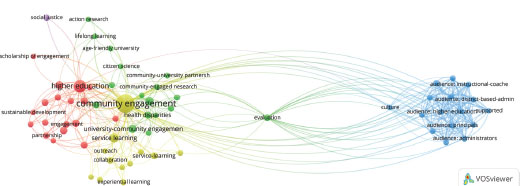
Source: Compiled by author.
Additionally, an examination of the dynamic evolution of keywords showed that before 2015, critical points on the subject were focused to basic themes about the link and partnership between academia and the community. After 2017, interest shifted towards more specific topics such as community development, community-based participatory research, service-learning, and more recently, the Covid-19 pandemic (Figure XI).
FIGURE XI. Keyword trend
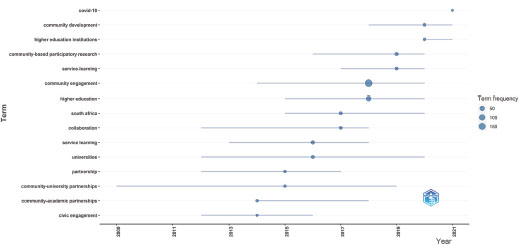
Source: Compiled by author.
The algorithm of Callon et al. (1991) allowed to identify a total of eight clusters distributed between motor, basic, niche, and emerging themes (Figure XII).
FIGURE XII. Thematic map of study categories
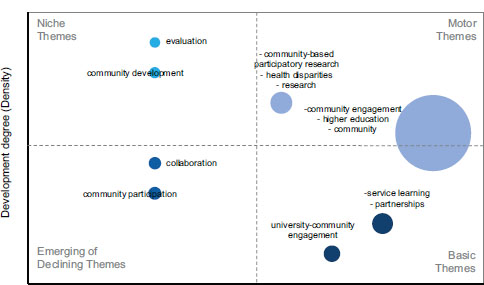
Source: Compiled by author.
The motor clusters were community engagement (189) and community-based participatory research (28). The first one grouped several case studies referring to the analysis and comparison of CE practices and policies in the world, applied in the context of higher education (Correa et al., 2012; Thomson et al., 2011; Winter et al., 2006). Others articles in this cluster address related topics such as University Social Responsibility (Chile & Black, 2015; Jones et al., 2021; Symaco & Tee, 2019) and Sustainable Development (Castro et al., 2021; Fissi et al., 2021; Mbah, 2018). The second cluster (which adds the concepts health disparities and research) grouped various publications associated with community-based participatory research (Johnston et al., 2019), its development complexities in particular areas such as health (Bodison et al., 2015; Weingart & Meyer, 2021), as well as reflections on the importance of institutionalizing CE as a university function (Bhagwan, 2020).
The basic clusters were university-community engagement (12) and service-learning (20). The first one explored, in general, the theoretical-conceptual framework on CE (Nkoana & Dichaba, 2017; Pink et al., 2016). The works of Ehlenz (2018) and Bruning et al. (2006) which reviewed the role and contribution of universities for the communities in which they are inserted, stand out. The second cluster investigated, mostly, the service-learning methodology. Works that propose service-learning projects based on criteria of horizontality and bidirectionality (Gerstenblatt & Gilbert, 2014), guides for the design of community education initiatives led by students (Bunting et al., 2019), and pedagogical discussions on the application of service-learning actions (Smith et al., 2017) stand out.
The niche clusters were evaluation (6) and community development (8). The first cluster included research that presents the results and impacts of various educational initiatives linked to the CE (Mann & Bowen, 2021; Powers & Leili, 2017) and the study of key indicators for their measurement (Wanjiru & Xiaoguang, 2021). And, in the second cluster, publications that analyzed the importance of establishing the link with the community engagement in stages of solutions design (Sheila et al., 2021) and the community impact in CE activities (Coetzee & Nell, 2018; Thomas et al., 2021) stand out.
The emerging or declining clusters were collaboration (10) and community participation (11). The first one, overall, explored the development of CE models to foster university-community collaboration (Bender, 2008; Bronstein et al., 2012; Swanberg et al., 2018). While the second covered a series of studies without major thematic integration, framed, however, in the field of mental health (Salzer et al., 2014, 2015; Snethen et al., 2021).
The study of CE in universities is an increasingly important topic that is fundamentally related to sustainable development and the social responsibility of universities; topics that define the landscape of community participation transversely.
The literature review denotes a strong geographic concentration and publication sources, whose scientific production is distributed among a large number of authors, and is framed in the areas of education and health. Key concepts associated with community engagement and development, health care and empirical research in the clinical, medical and educational fields, were highlighted.
Over the last fifteen years, the study of CE has shown a consistent dynamic evolution, progressing from incipient research focused on exploring the university-community link, to more specific topics that highlight particular methodologies and practices for ensuring effective engagement.
The thematic analysis of the bibliography reveals that the catalysts of this field of study are the creation and development of sustainable partnerships with community stakeholders, and the role of universities in providing relevant community services and participatory research. This means that, as a general framework for their articulation with the community, universities must establish bidirectional and formalized practices aimed at increasing social capital for sustainable development through a participatory and timely model, as has been highlighted by other researchers (Bender, 2008; Chen, 2021; Zapp & Lerch, 2020).
In this way, it is suggests that CE must be based on a strategic and operational model of holistic approach, which integrates the university disciplines and functions to give it a sense and orientation towards the mission and educational project (Bender, 2008; Kruss, 2012). Likewise, sustainable development and university social responsibility are factors closely connected with CE and represent, together with the development of participatory teaching and learning methodologies, basic aspects for student engagement with the community.
In this context, it is not surprising that the mobilizing elements highlighted in the literature refer to the study of action research and community-based research processes, as well as the tools that allow for evaluating their results and impacts. It highlights, for example, the interest in the service learning (SL) methodology, an educational proposal in which participants learn while working on improving real needs of the environment.
In conclusion, the results show that research within the framework of university CE has tended to raise the importance of this function as a strategic area of institutional management and a key aspect of academic management. Although it is still a flexible concept, there is a clear distinction between extension-volunteering actions and community engagement, because the latter must interact with other higher education functions. It is interesting to mention that although there is plenty of studies that scrutinize the university-community link, this is the first bibliometric review focused specifically on the notion of community engagement, which also includes a categorization based on the degree of interaction and strength of thematic association, facilitating new lines of research in the area. Thus, this research provides a general overview of the scientific production in CE in the context of university education.
For public policy makers, as well as academic managers, a general proposal for mechanisms for operationalization, monitoring and evaluation of the CE, synthesized in Figure XIII, is developed. It is important to note that the proposed mechanisms are built under a concrete policy framework that emphasizes the key roles of strategic planning, institutional leadership and effective control systems, and that ensure that the disclosure of information is open and transparent.
FIGURE XIII. Proposal of mechanisms for operationalization, monitoring, and evaluation of CE
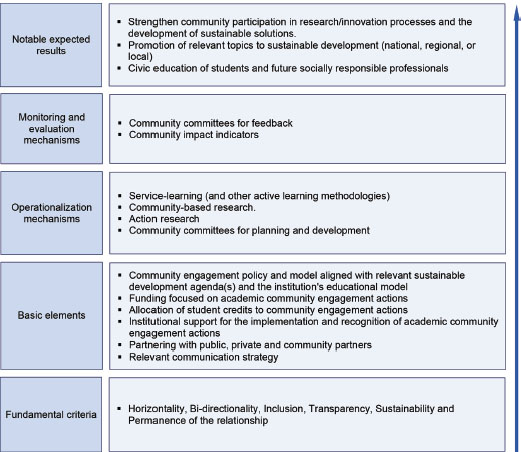
Source: Compiled by author.
Finally, the study presents some limitations and opportunities for future research. From the perspective of bibliometric analysis, the review horizon can be expanded, as well as the databases consulted and the analysis methods applied for investigating the structure and dynamics of research. Additionally, this exploration can be complemented and deepened with the investigation of the themes of the identified articles through, for example, the use of qualitative content analysis techniques. And from the results perspective, the findings show that although CE is a topic of general interest, its study focused on the field of health and medical sciences. Thus, the development of future research that considers other disciplinary areas such as social sciences, engineering and technology is encouraged. Also, it is relevant to strengthen the analysis on the link with community partners (programs, practices, and methodologies), whose treatment would allow progress towards its consolidation as a driving issue. Similarly, it is considered important to propose research focused on evaluating the impact of university CE actions, currently classified as a niche topic. Furthermore, given the concentration of the spatial distribution of scientific production, it is necessary to generate initiatives in other geographical contexts (such as Latin America) that would significantly expand the panorama of research on CE.
All these opportunities will offer new theoretical and practical implications that, together with the current demands and challenges concerning the quality of higher education, will lead to new academic discussions that must be addressed in the future, safeguarding the scientific rigor revealed in this bibliometric examination on CE in the university context.
Aria, M., & Cuccurullo, C. (2017). bibliometrix: An R-tool for comprehensive science mapping analysis. Journal of Informetrics, 11(4), 959–975. https://doi.org/10.1016/j.joi.2017.08.007
Bender, G. (2008). Exploring conceptual models for community engagement at higher education institutions in South Africa. Perspectives in Education, 26(1), 81–95.
Bhagwan, R. (2020). Towards the institutionalisation of community engagement in higher education in South Africa. Perspectives in Education, 38(2), 36–55. https://doi.org/10.18820/2519593X/PIE.V38.I2.03
Bhatnagar, S., Agrawal, S., Sharma, D., & Singh, M. (2020). Perception on the Community Engagement of Students of Higher Education Institutions. SSRN Electronic Journal, 1–16. https://doi.org/10.2139/ssrn.3664052
Bidandi, F., Ambe, A. N., & Mukong, C. H. (2021). Insights and Current Debates on Community Engagement in Higher Education Institutions: Perspectives on the University of the Western Cape. SAGE Open, 11(2), 1–11. https://doi.org/10.1177/21582440211011467
Bodison, S. C., Sankaré, I., Anaya, H., Booker-Vaughns, J., Miller, A., Williams, P., & Norris, K. (2015). Engaging the Community in the Dissemination, Implementation, and Improvement of Health-Related Research. Clinical and Translational Science, 8(6), 814–819. https://doi.org/10.1111/cts.12342
Bradford, S. (1985). Sources of information on specific subjects 1934. Journal of Information Science, 10(4), 85–86. https://doi.org/10.1177/016555158501000407
Breznitz, S. M., & Feldman, M. P. (2012). The engaged university. Journal of Technology Transfer, 37(2), 139–157. https://doi.org/10.1007/s10961-010-9183-6
Bronstein, L. R., Anderson, E., Terwilliger, S. H., & Sager, K. (2012). Evaluating a model of school-based health and social services: An interdisciplinary community-university collaboration. Children and Schools, 34(3), 155–165. https://doi.org/10.1093/cs/cds004
Brown, K., Shephard, K., Warren, D., Hesson, G., & Fleming, J. (2016). Using phenomenography to build an understanding of how university people conceptualise their community-engaged activities. Higher Education Research & Development, 35(4), 643–657. https://doi.org/10.1080/07294360.2015.1137880
Bruning, S. D., McGrew, S., & Cooper, M. (2006). Town-gown relationships: Exploring university-community engagement from the perspective of community members. Public Relations Review, 32(2), 125–130. https://doi.org/10.1016/j.pubrev.2006.02.005
Bunting, S. R., Saqueton, R., & Batteson, T. J. (2019). A Guide for Designing Student-Led, Interprofessional Community Education Initiatives About HIV Risk and Pre-Exposure Prophylaxis. MedEdPORTAL, 15, 10818. https://doi.org/10.15766/mep_2374-8265.10818
Callon, M., Courtial, J. P., & Laville, F. (1991). Co-word analysis as a tool for describing the network of interactions between basic and technological research: The case of polymer chemsitry. Scientometrics, 22(1), 155–205. https://doi.org/10.1007/BF02019280
Castro, A., Esmond, S., Perez, S., Scott, C., Jackson, T., & Passmore, S. R. (2021). Building Sustainable Organizational and Community Capacity for Research Partnerships: A Decade of Experience. Progress in Community Health Partnerships: Research, Education, and Action, 15(4), 553–560. https://doi.org/10.1353/cpr.2021.0045
Chen, A. S. (2021). Global Citizen Formation: Global Citizenship Education in Higher Education. In Governance and Citizenship in Asia. Springer. https://doi.org/10.1007/978-981-16-1959-5
Chile, L. M., & Black, X. M. (2015). University–community engagement: Case study of university social responsibility. Education, Citizenship and Social Justice, 10(3), 234–253. https://doi.org/10.1177/1746197915607278
Chung, B., Brown, A., Moreno, G., Cuen, P., Uy, V., Vangala, S., Bell, D., Washington, A., Norris, K., & Mangione, C. (2016). Implementing Community Engagement as a Mission at the David Geffen School of Medicine at the University of California, Los Angeles. Journal of Health Care for the Poor and Underserved, 27(1), 8–21. https://doi.org/10.1353/hpu.2016.0009
Chung, B., Norris, K., Mangione, C., del Pino, H. E., Jones, L., Castro, D., Wang, C., Bell, D., Vangala, S., Kahn, K., Brown, A. (2015). Faculty Participation in and Needs around Community Engagement within a Large Multiinstitutional Clinical and Translational Science Awardee. Clinical and Translational Science, 8(5), 506–512. https://doi.org/10.1111/cts.12314
Cobo, M. J., López-Herrera, A. G., Herrera-Viedma, E., & Herrera, F. (2011). Science Mapping Software Tools: Review, Analysis, and Cooperative Study Among Tools. Journal of the American Society for Information Science and Technology, 62(7), 1382–1402. https://doi.org/10.1002/asi.21525
Coetzee, H., & Nell, W. (2018). Measuring impact and contributions of South African universities in communities: The case of the North-West University. Development Southern Africa, 35(6), 1–17. https://doi.org/10.1080/0376835X.2018.1475218
Compagnucci, L., & Spigarelli, F. (2020). The Third Mission of the university: A systematic literature review on potentials and constraints. Technological Forecasting and Social Change, 161(March), 1–30. https://doi.org/10.1016/j.techfore.2020.120284
Correa, M. A., Butcher, J., & Howard, P. (2012). An international comparison of community engagement in higher education. International Journal of Educational Development, 32(1), 187–192. https://doi.org/10.1016/j.ijedudev.2011.04.008
Dave, G., Frerichs, L., Jones, J., Kim, M., Schaal, J., Vassar, S., Varma, D., Striley, C., Ruktanonchai, C., Black, A., Hankins, J., Lovelady, N., Cene, C., Green, M., Young, T., Tiwari, S., Cheney, A., Cottler, L., Sullivan, G., … Corbie-Smith, G. (2018). Conceptualizing trust in community-academic research partnerships using concept mapping approach: A multi-CTSA study. Evaluation and Program Planning, 66(2), 70–78. https://doi.org/10.1016/j.evalprogplan.2017.10.007
Donthu, N., Kumar, S., Mukherjee, D., Pandey, N., & Lim, W. M. (2021). How to conduct a bibliometric analysis: An overview and guidelines. Journal of Business Research, 133(May), 285–296. https://doi.org/10.1016/j.jbusres.2021.04.070
Dougnac, P. (2016). Una revisión del concepto anglosajón public engagement y su equivalencia funcional a los de extensión y vinculación con el medio. Pensamiento Educativo: Revista de Investigación Educacional Latinoamericana, 53(2), 1–19. https://doi.org/10.7764/PEL.53.2.2016.11
Dry, S., Garrett, S., Koenig, B., Brown, A., Burgess, M., Hult, J., Longstaff, H., Wilcox, E., Contreras, S., Martinez, A., Boyd, E., & Dohan, D. (2017). Community recommendations on biobank governance: Results from a deliberative community engagement in California. PLoS ONE, 12(2), e0172582. https://doi.org/10.1371/journal.pone.0172582
Ebersohn, L., Loots, T., Eloff, I., & Ferreira, R. (2015). Taking note of obstacles research partners negotiate in long-term higher education community engagement partnerships. Teaching and Teacher Education, 45(1), 59–72. https://doi.org/10.1016/j.tate.2014.09.003
Ehlenz, M. M. (2018). Defining University Anchor Institution Strategies: Comparing Theory to Practice. Planning Theory and Practice, 19(1), 74–92. https://doi.org/10.1080/14649357.2017.1406980
Fissi, S., Romolini, A., Gori, E., & Contri, M. (2021). The path toward a sustainable green university: The case of the University of Florence. Journal of Cleaner Production, 279, 1–9. https://doi.org/10.1016/j.jclepro.2020.123655
Forliano, C., De Bernardi, P., & Yahiaoui, D. (2021). Entrepreneurial universities: A bibliometric analysis within the business and management domains. Technological Forecasting and Social Change, 165(1–16). https://doi.org/10.1016/j.techfore.2020.120522
Gerstenblatt, P., & Gilbert, D. J. (2014). Framing Service Learning in Social Work: An Interdisciplinary Elective Course Embedded within a University–Community Partnership. Social Work Education, 33(8), 1037–1053. https://doi.org/10.1080/02615479.2014.935731
Gilmore, B., Ndejjo, R., Tchetchia, A., De Claro, V., Mago, E., Diallo, A. A., Lopes, C., & Bhattacharyya, S. (2020). Community engagement for COVID-19 prevention and control: A rapid evidence synthesis. BMJ Global Health, 5(10), 1–11. https://doi.org/10.1136/bmjgh-2020-003188
Govender, I., & Giampiccoli, A. (2020). Towards university involvement in community-based tourism monitoring & evaluation education. e-Review of Tourism Research, 18(2), 252–268.
Greenhill, J. A., Walker, J., & Playford, D. (2015). Outcomes of Australian Rural Clinical Schools: A Decade of Success Building the Rural Medical Workforce Through the Education and Training Continuum. Rural and Remote Health, 15(3), 1–14. https://doi.org/10.22605/RRH2991
Groark, C. J., & McCall, R. B. (2018). Lessons learned from 30 years of a university-community engagement center. Journal of Higher Education Outreach and Engagement, 22(2), 7–30.
Johnston, A., Wells, P., & Woodhouse, D. (2021). Examining the roles of universities in place-based industrial strategy: which characteristics drive knowledge creation in priority technologies? Regional Studies, 1–12. https://doi.org/10.1080/00343404.2021.1956683
Johnston, J., Lopez, M., Gribble, M. O., Gutschow, W., Austin, C., & Arora, M. (2019). A Collaborative Approach to Assess Legacy Pollution in Communities Near a Lead–Acid Battery Smelter: The “Truth Fairy” Project. Health Education and Behavior, 46(1S), 71S–80S. https://doi.org/10.1177/1090198119859406
Johnston, K., & Lane, A. (2018). Building relational capital: The contribution of episodic and relational community engagement. Public Relations Review, 44(5), 633–644. https://doi.org/10.1016/j.pubrev.2018.10.006
Jones, E., Leask, B., Brandenburg, U., & de Wit, H. (2021). Global Social Responsibility and the Internationalisation of Higher Education for Society. Journal of Studies in International Education, 25(4), 330–347. https://doi.org/10.1177/10283153211031679
Kruss, G. (2012). Reconceptualising engagement: A conceptual framework for analysing university interaction with external social partners. South African Review of Sociology, 43(2), 5–26. https://doi.org/10.1080/21528586.2012.694240
Kruss, G., Haupt, G., & Visser, M. (2016). ‘Luring the academic soul’: promoting academic engagement in South African universities. Higher Education Research & Development, 35(4), 755–771. https://doi.org/10.1080/07294360.2015.1137874
Lavery, J. V., Tinadana, P. O., Scott, T. W., Harrington, L. C., Ramsey, J. M., Ytuarte-Nuñez, C., & James, A. A. (2010). Towards a framework for community engagement in global health research. Trends in Parasitology, 26(6), 279–283. https://doi.org/10.1016/j.pt.2010.02.009
Levin, M. B., Bowie, J. V., Ragsdale, S. K., Gawad, A. L., Cooper, L. A., & Sharfstein, J. M. (2021). Enhancing Community Engagement by Schools and Programs of Public Health in the United States. Annual Review of Public Health, 42, 405–421. https://doi.org/10.1146/annurev-publhealth-090419-102324
Lotka, A. J. (1926). The frequency distribution of scientific productivity. Journal of the Washington Academy of Sciences, 16(12), 317–323.
Machimana, E., Ebersöhn, L., & Sefotho, M. (2018). What makes or breaks higher education community engagement in the South African rural school context: A multiple-partner perspective. Education Citizenship and Social Justice, 13(2), 177–196. https://doi.org/10.1177/1746197917731353
Machimana, E., Ebersöhn, L., & Sefotho, M. (2020). Higher education community engagement as a pathway to developing global citizenship practices in young people South African perspective. Citizenship Teaching and Learning, 15(3), 371–387.
Machimana, E. G., Sefotho, M. M., Ebersöhn, L., & Shultz, L. (2021). Higher education uses community engagement-partnership as a research space to build knowledge. Educational Research for Policy and Practice, 20(1), 45–62. https://doi.org/10.1007/s10671-020-09266-6
Mann, J., & Bowen, G. A. (2021). Emphasizing the Impact of Service-Learning and Community Engagement Partnerships Amid Challenges Facing Higher Education. International Journal for Research on Service-Learning and Community Engagement, 9(1), 1–5. https://doi.org/10.37333/001C.31379
Mbah, M. (2018). Can local knowledge make the difference? Rethinking universities’ community engagement and prospect for sustainable community development. The Journal of Environmental Education, 1–12. https://doi.org/10.1080/00958964.2018.1462136
Mbah, M., Johnson, A. T., & Chipindi, F. M. (2021). Institutionalizing the intangible through research and engagement: Indigenous knowledge and higher education for sustainable development in Zambia. International Journal of Educational Development, 82, 1–9. https://doi.org/10.1016/j.ijedudev.2021.102355
McNaughton, D., & Duong, T. T. H. (2014). Designing a Community Engagement Framework for a New Dengue Control Method: A Case Study from Central Vietnam. PLoS Neglected Tropical Diseases, 8(5), 1–12. https://doi.org/10.1371/journal.pntd.0002794
Mitchell, N., Triska, M., Liberatore, A., Ashcroft, L., Weatherill, R., & Longnecker, N. (2017). Benefits and challenges of incorporating citizen science into university education. PLoS ONE, 12(11), 1–15. https://doi.org/10.1371/journal.pone.0186285
Moher, D., Liberati, A., Tetzlaff, J., Altman, D. G., & Group, T. P. (2009). Preferred reporting items for systematic reviews and meta-analyses: The PRISMA statement. PLoS Medicine, 6(7). https://doi.org/10.1371/journal.pmed.1000097
Mtawa, N. N., Fongwa, S. N., & Wangenge-Ouma, G. (2016). The scholarship of university-community engagement: Interrogating Boyer’s model. International Journal of Educational Development, 49, 126–133. https://doi.org/10.1016/j.ijedudev.2016.01.007
Muñoz-Leiva, F., Viedma-del-Jesús, M. I., Sánchez-Fernández, J., & López-Herrera, A. G. (2012). An application of co-word analysis and bibliometric maps for detecting the most highlighting themes in the consumer behaviour research from a longitudinal perspective. Quality and Quantity, 46, 1077–1095. https://doi.org/10.1007/s11135-011-9565-3
Mutero, I., & Govender, I. (2019). Moving from Transactional Partnerships to Collaborative University Community Engagement: A Case Study Evaluating Creative Placemaking in Kwazulu-Natal Province. South African Review of Sociology, 50(1), 3–17. https://doi.org/10.1080/21528586.2019.1632578
Mutero, I., & Govender, I. (2020). Advancing the Exploration of Engaged Creative-Placemaking Amongst Universities and Communities for Social Cohesion in South Africa. Journal of Asian and African Studies, 55(3), 429–445. https://doi.org/10.1177/0021909619882718
Mutero, I., & Govender, I. (2021). Monitoring and Evaluation of Transformative Creative Placemaking on University Campuses. Journal of Asian and African Studies, 56(7), 1577–1589. https://doi.org/10.1177/0021909620975804
Nkoana, E. M., & Dichaba, M. M. (2017). Development and application of conceptual and analytic frameworks for community engagement at a South African higher education institution. South African Journal of Higher Education, 31(6), 177–196. https://doi.org/10.20853/31-6-1574
Osborne, J., Paget, J., Giles-Vernick, T., Kutalek, R., Napier, D., Baliatsas, C., & Dückers, M. (2021). Community engagement and vulnerability in infectious diseases: A systematic review and qualitative analysis of the literature. Social Science and Medicine, 284(July), 1–12. https://doi.org/10.1016/j.socscimed.2021.114246
Petersen, I., & Kruss, G. (2021). Universities as change agents in resource-poor local settings: An empirically grounded typology of engagement models. Technological Forecasting and Social Change, 167(2), 120693. https://doi.org/10.1016/j.techfore.2021.120693
Pink, M. A., Taouk, Y., Guinea, S., Bunch, K., Flowers, K., & Nightingale, K. (2016). Developing a conceptual framework for student learning during international community engagement. Journal of University Teaching and Learning Practice, 13(5).
Pommier, E., Neff, K. D., & Tóth-Király, I. (2020). The Development and Validation of the Compassion Scale. Assessment, 27(1), 21–39. https://doi.org/10.1177/1073191119874108
Powers, R. A., & Leili, J. (2017). Bar Training for Active Bystanders: Evaluation of a Community-Based Bystander Intervention Program. Violence Against Women, 1–21. https://doi.org/10.1177/1077801217741219
Richardson, E. Z. L., Bandewar, S. V. S., Boulanger, R. F., Mehta, R., Lin, T., Vincent, R., Molyneux, S., Goldstone, A., & Lavery, J. V. (2021). Addressing diversity and complexity in the community engagement literature: The rationale for a realist review. Wellcome Open Research, 5(1), 1–16. https://doi.org/10.12688/wellcomeopenres.15525.2
Robertson, S. L. (2021). Global competences and 21st century higher education – And why they matter. International Journal of Chinese Education, 10(1), 1–9. https://doi.org/10.1177/22125868211010345
Ryan, B., Johnston, K. A., Taylor, M., & McAndrew, R. (2020). Community engagement for disaster preparedness: A systematic literature review. International Journal of Disaster Risk Reduction, 49(March), 1–13. https://doi.org/10.1016/j.ijdrr.2020.101655
Salzer, M. S., Brusilovskiy, E., Prvu-Bettger, J., & Kottsieper, P. (2014). Measuring community participation of adults with psychiatric disabilities: Reliability of two modes of data collection. Rehabilitation Psychology, 59(2), 211–219. https://doi.org/10.1037/a0036002
Salzer, M. S., Kottsieper, P., & Brusilovskiy, E. (2015). Intermethod reliability and factors affecting recall with the Temple University Community Participation measure. Journal of Mental Health, 24(4), 189–195. https://doi.org/10.3109/09638237.2015.1036976
Sheila, N. A., Zhu, C., Kintu, M. J., & Kataike, J. (2021). Assessing higher education institutional stakeholders’ perceptions and needs for community engagement: An empirical evidence from Uganda. Heliyon, 7(4), 1–9. https://doi.org/10.1016/j.heliyon.2021.e06612
Shephard, K., Brown, K., & Guiney, T. (2017). Researching the Professional-Development Needs of Community-Engaged Scholars in a New Zealand University. Sustainability, 9(7), 1249. https://doi.org/10.3390/su9071249
Shephard, K., Brown, K., Guiney, T., & Deaker, L. (2018). Valuing and evaluating community-engaged scholarship. Tertiary Education and Management, 24(1), 83–94. https://doi.org/10.1080/13583883.2017.1395904
Skute, I., Zalewska-Kurek, K., Hatak, I., & de Weerd-Nederhof, P. (2019). Mapping the field: a bibliometric analysis of the literature on university–industry collaborations. Journal of Technology Transfer, 44(3), 916–947. https://doi.org/10.1007/s10961-017-9637-1
Smith, B. D., Marshall, I., Anderson, B. E., & Daniels, K. K. (2017). A partnership forged: BSW students and service learning at a historically Black college and university (HBCU) serving urban communities. Journal of Human Behavior in the Social Environment, 27(5), 438–449. https://doi.org/10.1080/10911359.2017.1295005
Snethen, G., Brusilovskiy, E., McCormick, B. P., Hiremath, S. V., & Salzer, M. S. (2021). The relationship between community participation and physical activity among individuals with serious mental illnesses. Mental Health and Physical Activity, 20(2021), 1–8. https://doi.org/10.1016/j.mhpa.2021.100381
Swanberg, S. M., Mi, M., Engwall, K., & Bulgarelli, N. (2018). Community Engagement at an Emerging Academic Medical Library: A Three-Pronged Outreach Model. Medical Reference Services Quarterly, 37(3), 234–248. https://doi.org/10.1080/02763869.2018.1477707
Symaco, L. P., & Tee, M. Y. (2019). Social responsibility and engagement in higher education: Case of the ASEAN. International Journal of Educational Development, 66, 184–192. https://doi.org/10.1016/j.ijedudev.2018.10.001
Thomas, E., Snethen, G., & Salzer, M. (2017). A developmental study of community participation of individuals with serious mental illnesses: Implications for policy and practice. American Journal of Orthopsychiatry, 87(5), 597–605. https://doi.org/10.1037/ort0000269
Thomas, T., Joseph, M. K., Nazar, L., Ravi, S., & Vijesh, P. V. (2021). Engaging in Community Development Practices, Public Libraries as Flagship Bearers: A case study of Mulanthuruthy Public Library in Ernakulum District, Kerala, India. Library Philosophy and Practice, 1–11.
Thomson, A. M., Smith-Tolken, A. R., Naidoo, A. V., & Bringle, R. G. (2011). Service Learning and Community Engagement: A Comparison of Three National Contexts. Voluntas, 22(2), 214–237. https://doi.org/10.1007/s11266-010-9133-9
Unger, M., & Polt, W. (2017). The knowledge triangle between research, education and innovation -A conceptual discussion. Foresight and STI Governance, 11(2), 10–26. https://doi.org/10.17323/2500-2597.2017.2.10.26
UNICEF. (2020). Minimum Quality Standards and Indicators for Community Engagement. UNICEF.
an Eeden, E., Eloff, I., & Dippenaar, H. (2021). On Responses of Higher Education and Training With(in) Society Through Research, Teaching and Community Engagement. Educational Research for Social Change, 10(1), 1–15.
Wanjiru, I. R., & Xiaoguang, L. (2021). Evaluating University–Community Engagement Through a Community-Based Lens: What Indicators Are Suitable? Journal of Higher Education Outreach and Engagement, 25(4), 133–152.
Weerts, D. (2014). State Funding and the Engaged University: Understanding Community Engagement and State Appropriations for Higher Education. The Review of Higher Education, 38(1), 133–169. https://doi.org/10.1353/rhe.2014.0038
Weerts, D. (2016). From Covenant to Contract: Changing Conceptions of Public Research Universities in American Society. The Good Society, 25(2-3), 182–208. https://doi.org/10.5325/goodsociety.25.2-3.0182
Weerts, D. J., & Sandmann, L. R. (2008). Building a two-way street: Challenges and opportunities for community engagement at research universities. Review of Higher Education, 32(1), 73–106. https://doi.org/10.1353/rhe.0.0027
Weerts, D. J., & Sandmann, L. R. (2010). Community engagement and boundary-spanning roles at research universities. The Journal of Higher Education, 81(6), 632–657. https://doi.org/10.1080/00221546.2010.11779075
Weingart, P., & Meyer, C. (2021). Citizen science in South Africa: Rhetoric and reality. Public Understanding of Science, 30(5), 1–16. https://doi.org/10.1177/0963662521996556
Winter, A., Wiseman, J., & Muirhead, B. (2006). University-community engagement in Australia: Practice, policy and public good. Education, Citizenship and Social Justice, 1(3), 211–230. https://doi.org/10.1177/1746197906064675
Yuan, M., Lin, H., Wu, H., Yu, M., Tu, J., & Lü, Y. (2021). Community engagement in public health: a bibliometric mapping of global research. Archives of Public Health, 79(1), 1–17. https://doi.org/10.1186/s13690-021-00525-3
Zapp, M., & Lerch, J. C. (2020). Imagining the World: Conceptions and Determinants of Internationalization in Higher Education Curricula Worldwide. Sociology of Education, 93(4), 372–392. https://doi.org/10.1177/0038040720929304
Zavale, N. C., & Langa, P. V. (2018). University-industry linkages’ literature on Sub-Saharan Africa: systematic literature review and bibliometric account. Scientometrics, 116(1), 1–49. https://doi.org/10.1007/s11192-018-2760-4
Zhu, J., & Liu, W. (2020). A tale of two databases: the use of Web of Science and Scopus in academic papers. Scientometrics, 123(2), 321–335. https://doi.org/10.1007/s11192-020-03387-8
Zupic, I., & Čater, T. (2015). Bibliometric Methods in Management and Organization. Organizational Research Methods, 18(3), 429–472. https://doi.org/10.1177/1094428114562629
Contact address: Sebastián Araya-Pizarro. Universidad de La Serena, Facultad de Ciencias Sociales, Empresariales y Jurídicas, Departamento de Ciencias Económicas y Empresariales, Amunátegui s/n, La Serena, Chile. E-mail: saraya@userena.cl